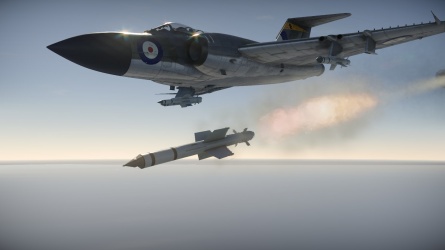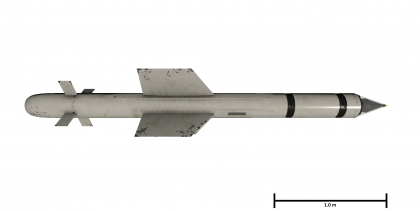Firestreak

Contents
Description
The Firestreak is a British Infrared homing air-to-air missile. it was introduced in Update 1.85 "Supersonic".
Vehicles equipped with this weapon
General info
| Missile characteristics | |
|---|---|
| Mass | 136 kg |
| Guidance | IR |
| Aspect | Rear-aspect |
| Lock range (rear-aspect) | 4 km |
| Launch range | 7 km |
| Maximum speed | 3.4 M |
| Maximum overload | 15 G |
| Missile guidance time | 13 secs |
| Explosive mass | 11.2 kg TNTeq |
The Firestreak is a large missile, with an 8.75 kg warhead (11.2 kg TNTe). The Firestreak is a very early air-to-air missile design; it was Britain's first operational heat seeking missile. It has slightly better manoeuvrability than other early heat seeking missiles, and a much larger warhead, and is otherwise comparable in terms of speed and range.
Effective damage
The Firestreak has a 8.75 kg warhead, making it capable of outright destroying any target it gets a direct hit on. The warhead has a larger proximity fuse setting than other heat-seeking missiles (10 m as opposed to the more standard 5 m), this helps slightly offset the missiles poor manoeuvrability as any aircraft caught in the proximity fuse range is likely to suffer critical damage due to the large explosive mass.
Comparison with analogues
The Firestreak has a warhead of 11.2 kg in explosive mass, just less than thrice than that of the AIM-9B, which only contains 4.5 kg. It is also slightly more manoeuvrable than the AIM-9B with a 15 G max overload compared to the AIM-9B's 10 G. Unlike other contemporary IR missiles, it also features the ability to slave to radar, which it shares with its cousin the Red Top.
Usage in battles
This missile is not agile. Do not use them on targets that are manoeuvrable as they will easily evade it. Instead, use them on bombers or aircraft which have no energy left to manoeuvre as it will be more difficult for them to evade the missile.
As this missile seeks infrared radiation (IR), be aware of locking onto other sources of heat which can throw the missile off course such as other teammates, flares and of course, the sun.
The missile's IR seeker head can be slaved to radar. What this means is that once a pilot establishes a radar lock and activate the missile's seeker, the seeker head will search for heat signatures on the location of your radar lock, rather than directly ahead of it. This is very useful because the missiles have poor G-limits for launching, meaning a pilot needs to maintain an almost straight course to launch the Firestreak. Slaving to radar allows a pilot to automatically "lead" the missile seeker within its range of motion, similar to what can be done with the AIM-9G and other later missiles after acquiring an IR lock, and can be used to launch missiles from oblique angles.
Like other air-to-air missiles, the Firestreak performs best at altitude where there is less drag from the reduced air concentration, allowing it to maintain the speed it gets from its initial burn time.
Pros and cons
Pros:
- Has the second largest warhead of any air to air missile
- The IR seeker has a fairly wide field of view when slaved to the Javelin, Lightning, or Sea Vixen's radar
- Can be slaved to radar
- Highly receptive proximity fuse
- 15G overload
Cons:
- Slightly lower velocity than other missiles
- Relatively short range compared to counterparts
History
De Havilland's Firestreak was the first British infrared guided missile to enter service, arming the Gloster Javelin, de Havilland Sea Vixen, and, later, the English Electric Lightning.
Development was the result of a somewhat confused post-war process that started in 1945 with a very ambitious design known as "Red Hawk". When this proved too complicated, a simpler system known as "Blue Sky" was proposed in 1949 and eventually emerged in 1956 as Fireflash. Shortly after Fireflash development started, advances in infrared guidance suggested a new look at the original Red Hawk concept, and eventually a specification emerged as "Blue Jay".
Blue Jay began development in November 1951. Many of the technologies were entirely new, and development took considerable time. One significant issue was the size and power requirements of the tube-based electronics, which took up much of the forward quarter of the missile body. This left no room for the warhead, which had to be moved to the rear of the missile, thereby taking up the area that would normally be used for the control fin actuators. These were instead placed in the electronics section, operating the rear-mounted fins using long pushrods. To further complicate it, the power for the actuators were air bottles in the tail. The layout was quite complicated.
The first launches took place in 1955, and it entered service with the RAF in 1957 and the Royal Navy in 1958. Designed specifically for use against bombers and other large targets, it was not particularly manoeuvrable and its overall performance was less than that of the AIM-9 Sidewinder that had entered US service the previous year. It made up for this somewhat with the use of a very large warhead, well over double the weight of Sidewinder's.
Several minor modifications to the basic design were suggested but not implemented. These eventually led to a much more capable upgrade, the Hawker Siddeley Red Top.
Media
Excellent additions to the article would be video guides, screenshots from the game, and photos.
See also
Links to the articles on the War Thunder Wiki that you think will be useful for the reader, for example:
- reference to the article about the variant of the weapon;
- references to approximate analogues by other nations and research trees.
External links




